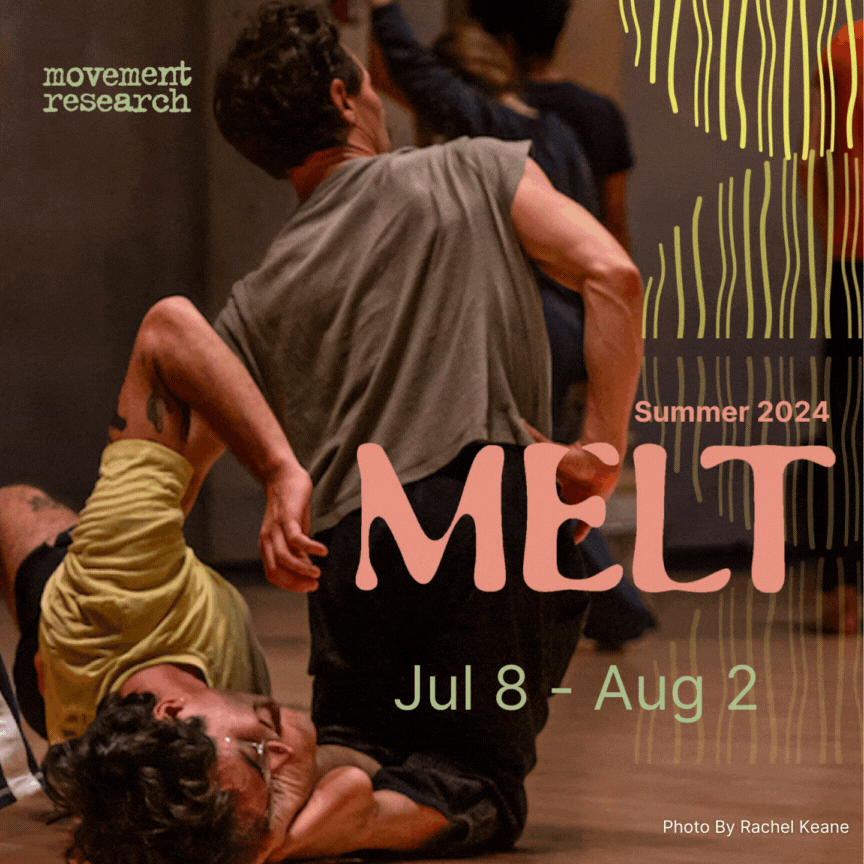“We are exploring the notion of crossroads or intersection, where a person comes to an intersection and has four directions they can take.” Julia Koch and Daniel Zippi, co-directors of the Barcelona-based collective por instantes, talked in advance of their U.S. debut at the Baryshnikov Arts Center, where they will perform the dance-theater work La Travesia from June 14-17. Zippi and Koch discuss their roles as theater director (Zippi) and choreographer (Koch) and their interest in translating urban spaces to the stage.
Interview Date: June 4, 2012
Download a PDF of this conversation
Daniel Zippi: How did you come to Barcelona?
Julia Koch: I wanted to study here. There was a program at the conservatory here, which I decided to do. It’s a four-year, full-day program and another year where you prepare your final project.
Daniel: I should probably mention where we met. I was invited to participate in a production that was originally done by Ridge Theater of a Mac Wellman play called, Jennie Richiee, or: Eating Jalooka Fruit Before It’s Ripe. I was invited to be in residence with the Stas Theatre Darmstadt to enact a role I had done in New York and in Chicago. Julia was one of the dancers in the production and this is where we met and found our mutual interests in the combination of dance and theater. Many years had passed, Julia had since moved to Barcelona and continued her choreographic studies in tandem with her performing.
Julia: We started to develop our first piece in the facilities at the Institute de Theatre de Barcelona.
Daniel: That project was Projecte: La Plage, a dance theatre piece set in a train station. We worked at that time with a number of musicians in New York to create a score—very interesting musicians we had met through the Bang on a Can community and they created a wonderful score. La Travesia is the second in what we considered a three part series of dance theatre projects set in public spaces. La Travesia is set in an urban intersection; a place where people make decisions. The vocabulary of the show is mostly contemporary dance with a few intersections into subtle theater practices.
Julia: In the first project I came up with all the movements. I really marked every step but, on the other hand, I also had the dancer always on my side in a room so I tried to pick up on the body energy that the dancer gave me, so it was an intuitive process as well. On the second project we already knew the dancers because we had worked with them so we were interested in their different characters. So, we decided to work from improvisations. We filmed guided improvisations where we first explained to the dancer in which situation he was in and the dancer had to imagine a body atmosphere. We would select moments and we would construct [the choreography] from those moments.

Daniel: A lot of what we do is based in ambient recordings of the places that we are depicting. In Projecte: La Plage we went to various train stations in Spain, in Barcelona, and France. In La Travesia we went to intersections in Barcelona and recorded the ambient sound of the cars, the people, the footsteps. Sometimes we put these soundtracks beneath these improvisations that the dancers were doing and sometimes they would inform them.
Carsten Gallay, a German who lives here in Barcelona, took the ambient recordings and manipulated them electronically. The base of the soundtrack for La Travesia comes in and out of the ambient recordings and comes into the electronic music and into acoustic music that we worked [on] with other musicians here in Barcelona. There’s an accordion, there’s a cahone, there’s a frame drum, a guitar. Julia once described this as the dramaturgy to our pieces. It’s an oral dramaturgy.
Our pieces take place in episodes so each piece has its own little section, like a set list for a band almost. Sometimes those pieces are interchangeable according the abstract narrative that they create. A strange narrative or accumulation arises from that material in tandem with the music and the ambient recordings.
Julia: I think what we do is work a moment, an instant of an action.

Daniel: Hence the name of our company, which is por instantes, which can mean several things: by moments or for moments. We take the idea of an expanded moment, something that can take two to three seconds in reality, and expand it anywhere from three-minute to ten-minute episodes. We have a story in mind that may or may not be apparent for each of the characters that are coming through. Hopefully the audience follows these characters and has an accumulated sense of their personas.
Julia: The pieces are never a linear story. In real life sometimes things don’t have continuation or may have continuation much later in life.
Daniel: One of the things that Julia is alluding to, which is important to us, is that the places we are depicting are often places of people in transition. In Projecte: La Plage it was set in a train station where people are waiting for trains, waiting for loved ones to arrive on trains. In La Travesia we are exploring the notion of crossroads or intersection, where a person comes to an intersection and has four directions they can take. We explored the decision making process in each of these characters.
Julia: What was new on La Travesia, for me and the dancers especially, was to introduce text. We allowed the dancers to mix their body improvisation also with text. We found it sometimes a little odd, but somehow fitting, to mix those two genres.
Daniel: It is improvised text. What we try to do is to make the dancers comfortable with speaking as well as moving to express whatever they feel in the moment. These experiments make what we consider our own little unique collision of dance and theatre. There is a fluidity and an ease that a dancer has with their body that I don’t experience in theatre a lot. A lot of theatre is stiff physically and uses words to convey an emotion or thought or meaning. In our work we encourage the use of both theatrical elements and movement elements and we’re hoping to create our own vocabulary.
One of the reasons we are working in Barcelona is because there is a rich community of movement artists here and, I found recently, of musicians and technicians that are willing to work on projects with little resources. That is possible here in Barcelona. I guess it’s still possible in New York, if you are very tenacious and resourceful. One of the great things about the development of La Travesia is that we were invited for a residency at the Antic Teatre’s space in AdriAntic, which is in a warehouse space and it was a lovely place to develop a work. We are currently redeveloping the work in a very beautiful place in La Sagrara, more toward the center of Barcelona. It’s in a wonderful space called Naw Evanal, a beautiful old factory converted into theater spaces and rehearsal spaces. You feel the great freedom in creating there don’t you?
Julia: I do. It’s perfect. We received the keys so we can go when we want.
Daniel: Yeah, maybe we shouldn’t say this in case others want to do it [laughs].
One of the things about La Travesia that we should discuss is that Projecte: La Plage was meant to be viewed as what they call in Europe, an “Italian arrangement,” a more conventional, proscenium arrangement. La Travesia is conceived to be “in the round” as we say in America. It has audience on all four sides and the performing area is five meters by five meters, which is very small for a dance production. The audience is in very close proximity to the dancers, so they can feel the energy. It’s wonderful for the intersection of dance and theater because subtle moments can be realized by people very close to them. This creates an interesting challenge, especially for Julia.

Julia: Yes, because it has four fronts of course, so it really needs to be recognizable from all sides. That was new. But sometimes restrictions bring out more interesting products or moments. It was richer in the end—a total new thing—surprises for me, choreographically, and for the dancers. I think now that they are used to the four sides, they start to really play with it get used to the idea that they are going to be close to the people sitting around. When we first performed it, we didn’t know how that was going to be. But it gave us an energy. A total impulse for the performer.
Daniel: It’s true. One of the things that we try to do is try to make the performers have a casual relationship with the audience. They can look at the audience; they can talk to the audience; they can include the audience in their own private moment on stage, which is an old classical theatre thing in Greek theater and Shakespeare: you include the audience in your private moment.
Also, our works are conceived geometrically. Projecte: La Plage was the representation of three parallel train platforms that ran parallel to the proscenium. La Travesia is in an X, so the audience is on four sides and the crossroads run through them as lanes between the audience banks. So in Projecte: La Plage the movement was linear across the stage or through and around. And, in La Travesia people come and go in the crossroads.
Julia: Or circular movements as in an ancient arena of sport.
Daniel: Or a parade route.
Julia: It can suggest different things or different moments.
Daniel: It’s true. Our next piece, Hostile Rivera, is conceived to be on a wharf in a marina or a harbor and it’s an even more limited. The wharf will be represented by platforms on a diagonal and the audience will sit around in informal groupings.
Is there anything else we should talk about? All I can say is to come to the Baryshnikov Arts Center from June 14th to 17th. We are going to be in the Howard Gilman Performance Space in an environmental setting, in an intimate setting, with five dancer-performers, and even I come on the stage every once in a while.






